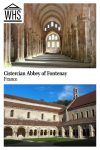Cistercian Abbey of Fontenay
By Rachel Heller
What is the Cistercian Abbey of Fontenay?
The Abbey of Fontenay is a former Cistercian Abbey in Bourgogne Franche-Comté, France, dating to the 12th century. Founded by St. Bernard, it is remarkably intact: all except the original refectory are still standing.
The Cistercian Order followed the ideas of St. Benedict, who preached poverty and self-sufficiency. At the Abbey of Fontenay they created a fully self-sufficient monastic society, supplying their own needs while they lived a life of solitude.
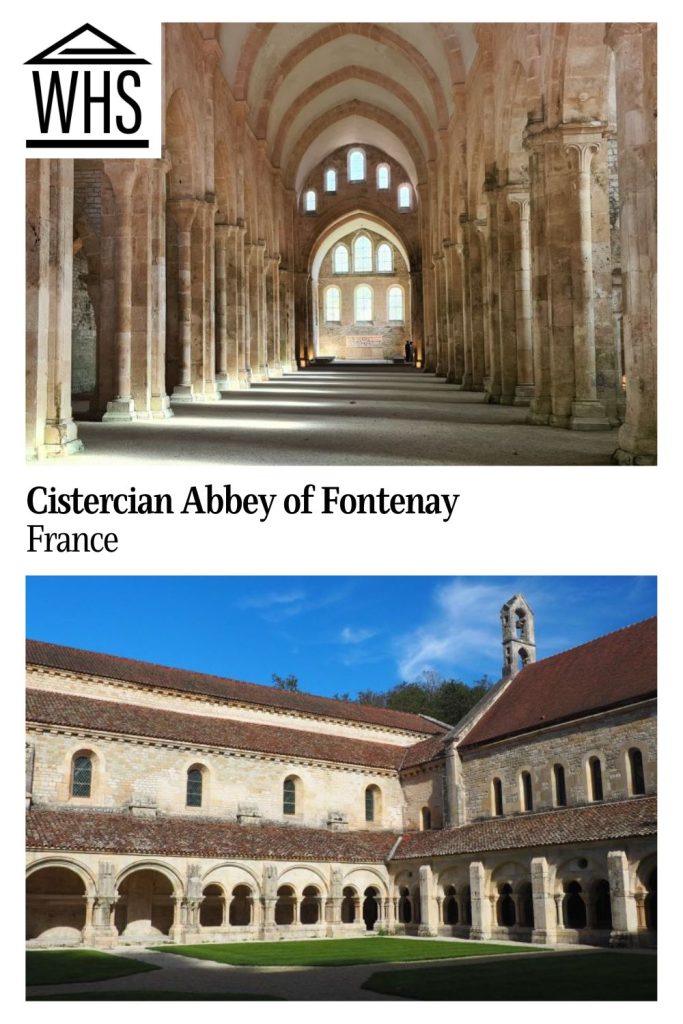
Disclosure: This article contains affiliate links. Making a purchase through an affiliate link will mean a small commission for this website. This will not affect your price. Privacy policy.
Even the location reinforced their ideals in that the abbey sits on land that was swampy until the monks drained it. It is to this day rather isolated in a long valley surrounded by forest. Over time, the abbey became wealthy, partly through the livestock they raised, but primarily through the innovative forge they operated.
The forge operated as early as the 12th century. The monks mined iron ore in the hill nearby. They diverted a stream to turn a water wheel which operated a large hydraulic hammer. Using this invention, they became wealthy, producing various tools that they sold nearby.
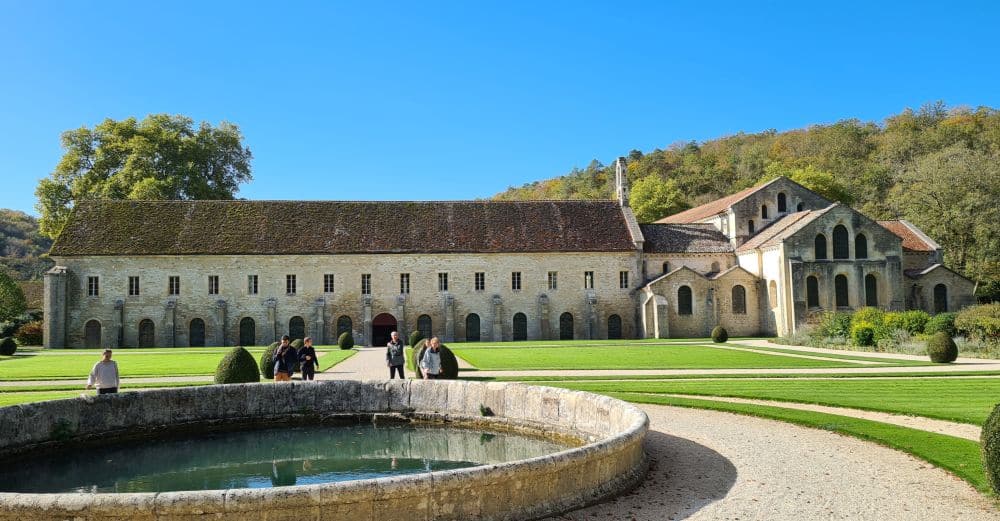
The abbey declined in the 16th century, and then, during the French Revolution, like all property of the Catholic Church, it was sold off by the state. In the 19th century the compound was used as a paper mill, but a later owner, Edouard Aynard, who bought the property in 1906, restored it to its former glory and removed all the changes and additions connected to the paper mill. The abbey still belongs to the Aynard family.
Why is the Cistercian Abbey of Fontenay a UNESCO World Heritage site?
According to UNESCO, the abbey is “an excellent illustration of the ideal of self-sufficiency as practised by the earliest communities of Cistercian monks.” The architecture is very simple and severe. UNESCO calls it “austere” and says that it “represents the physical form of the moral and aesthetic ideals which flourished at various times in the history of western Christian religious communities.”
What can you expect on a visit to Fontenay Abbey?
The abbey is a compound composed of a number of buildings, some of which visitors can enter: the church, the dormitory, the cloister, the chapter house, the monk’s room, the calefactorium, and the forge. A folder that you can pick up at the reception includes a map and a brief explanation of each one and how it was used. None of them is furnished in any way, but that just emphasizes the severe and elegant architecture.
The church
The architecture of the church is Romanesque, with elegant barrel vaulting. The way the light fell through the high windows from the side when we visited was beautiful. The pillars supporting the arches are remarkably plain, at least compared to pretty much every other Catholic church I’ve ever seen. They have very simple leaf patterns on them, uncomplicated yet pleasing. Apparently the idea was that the decoration of the church, such as it is, should not distract the monks from their prayers and contemplation.
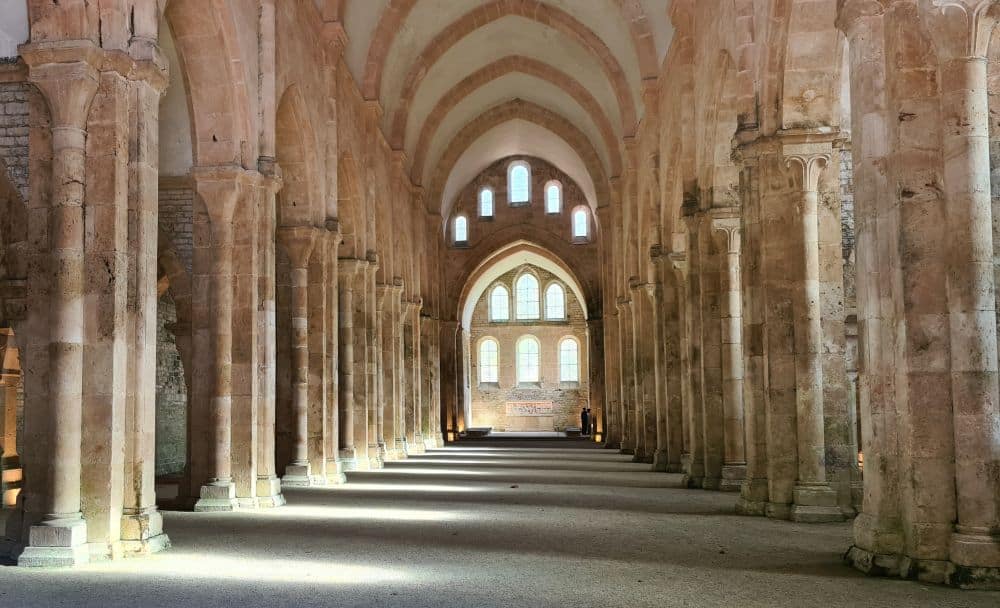
The stained-glass windows follow the same aesthetic. Rather than being brightly colored and illustrating Bible stories, they are simple patterns of barely-stained glass.
When we were in the church, a small group of visitors – one wearing a priest’s collar – broke into song. It was clearly a religious song, sounding like some sort of Gregorian chant. It echoed hauntingly in that large, elegant space.
The dormitory
This is a large room up a stairway from the church. The vaulted roof of oak dates to the 15th century. Monks slept here on pallets on the floor with dividers between them.
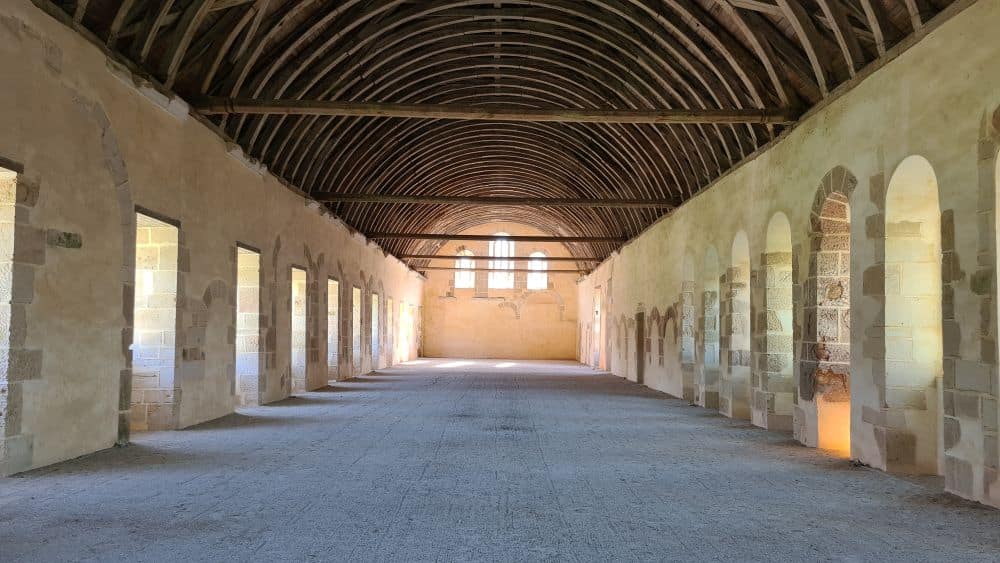
The cloister
A four-sided cloister, open to a plain courtyard, has the same very plain columns as in the church: no distraction for the monks.
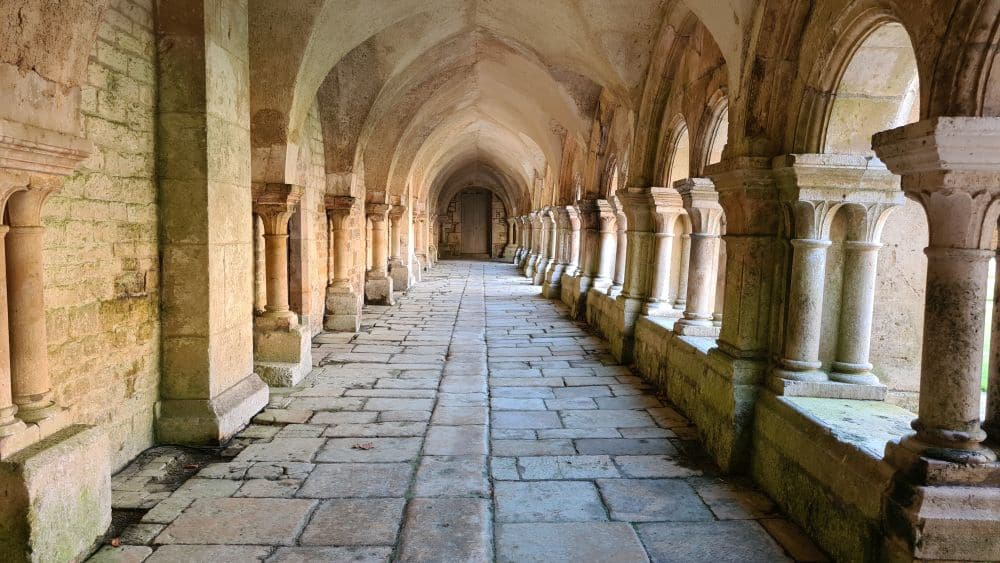
The monk’s room
This room has a vaulted roof like in the church, but the vaults are much lower. It was used for monastery work – things like recopying manuscripts and such.
The calefactorium
This heating room with two large fireplaces heated the monk’s room and the dormitory. Judging by the height of that dormitory ceiling, it could never have warmed the whole place. These monks did not live comfortably!
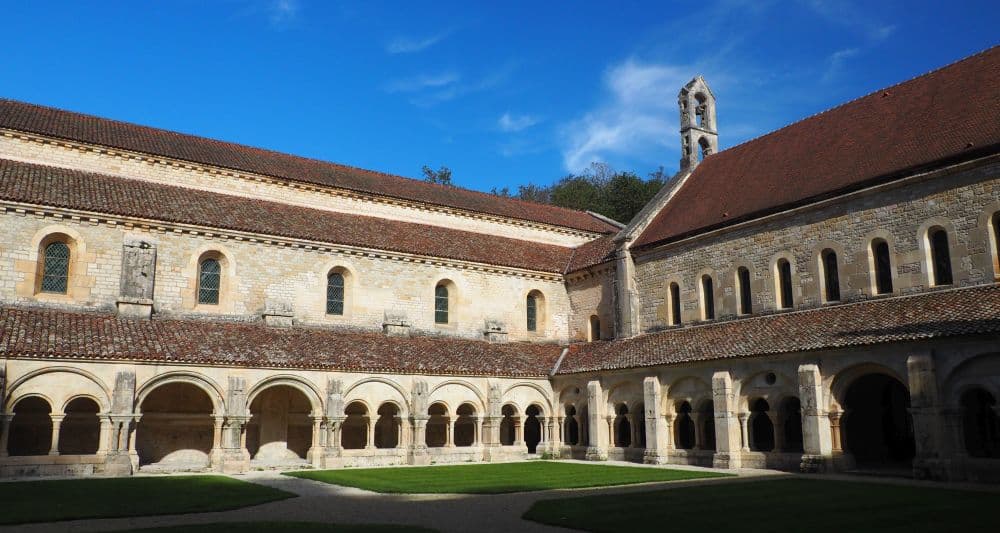
The forge
The forge is huge – almost as big as the church – and has the same kind of vaulting, but without much of even the minimal amount of carved decoration that the church has. One of the two fireplaces has been rebuilt to show how the work was done: it’s huge, and so is the bellows next to it. More interesting, though, is the replica of the hydraulic hammer. The shaft still turns thanks to the restored water wheel outside, but when we visited the gears had been detached so that the hammer didn’t actually rise and fall.
The garden
There’s a very austere garden as well with some extremely exact topiary and a fountain. I suppose in the abbey’s heyday the area would have been planted for food and/or medicinal crops of some sort.
Other elements
Other buildings can only be viewed from the outside: a prison (though it may have been a treasury), the 18th-century lodgings for the abbots appointed by the king, a 13th-century dovecote, and a gatekeeper’s house.
The whole collection leaves a serene impression. It’s a charming and, if you’re inclined that way, spiritual place.
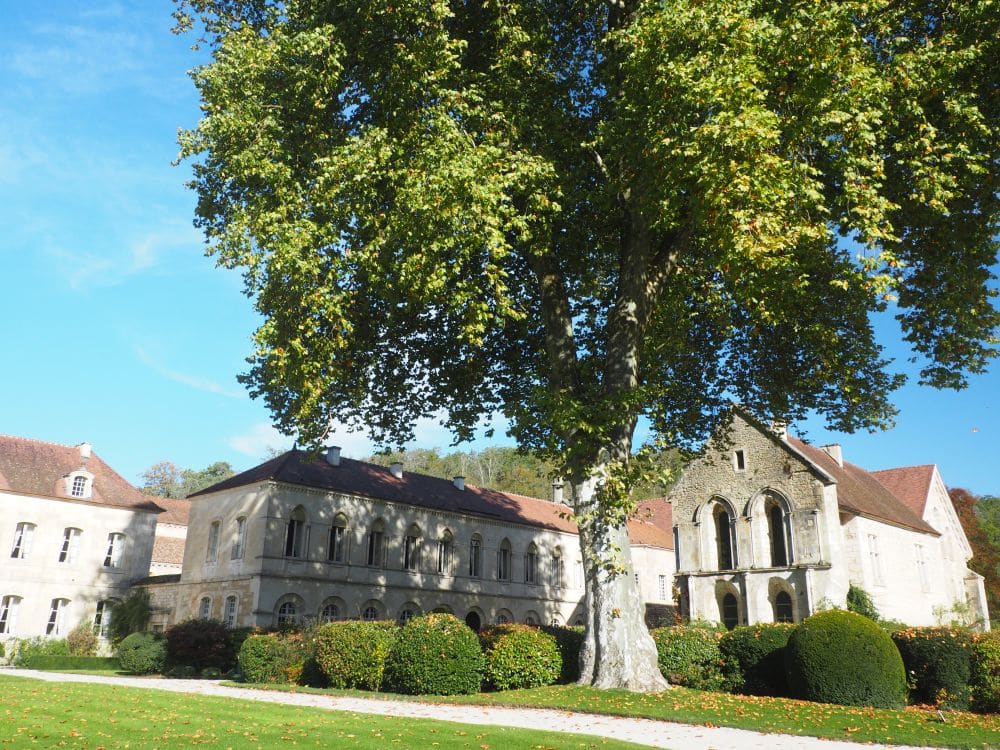
Is the Cistercian Abbey of Fontenay worth visiting?
In my view, it’s not worth making a special trip, but if you’re in Burgundy and passing nearby, it’s worth stopping and taking a look. Certainly if you are a spiritual person, you might like to visit here to spend some reflective time in the church or on the grounds. If Romanesque architecture is your thing, this very simplified version of it might be interesting to you.
There were people who’d brought their kids when we visited, but there’s not much to keep them entertained, so you’re likely to have to make it a quick visit. Voices echo around these spaces, so you might end up spending your time trying to keep the children quiet.
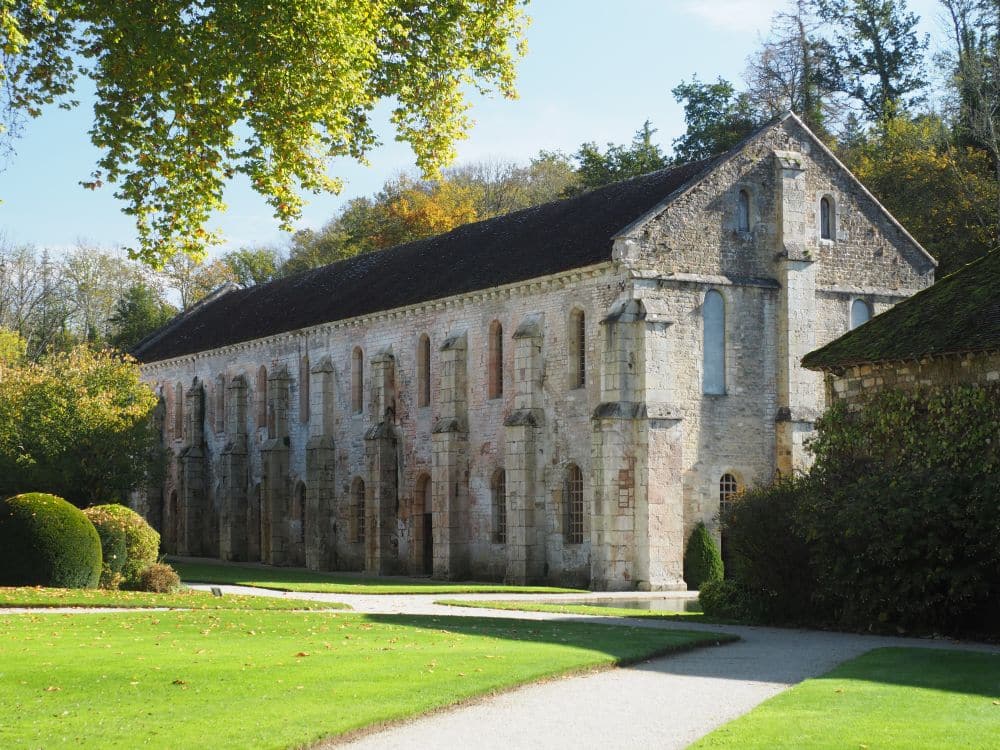
Tips for visiting the Abbey of Fontenay
Unless this is a spiritual journey for you, visiting the abbey should only take about an hour.
We visited in October. It was midday and there was one tour bus and a scattering of other tourists. In the summer, I’m sure it’s more crowded.
Most of the site seems to be wheelchair accessible, with an occasional step you might need help with. The dormitory, though, is up a flight of stairs. An informational film and maquette are also inaccessible, upstairs in what used to be the laymen’s chapel but is now a small museum.
We didn’t check them out, but there are some trails in the forest around the abbey. There is also a café, but we had brought our own lunch so I don’t know what was available.
Save time by buying your tickets ahead of time.
On our way back, traveling in the direction of Dijon, we stopped at Flavigny-sur-Ozerain. It’s an absolutely lovely medieval village on the top of a hill. Laced with narrow streets and stone houses, it’s definitely worth a look if you’re in the neighborhood anyway, traveling by car. Better yet, stay there a night or two!
Fontenay Abbey is within a couple of hours of several other UNESCO sites: The Climats of Burgundy (a lovely wine-growing region), Vézelay (another abbey, but with a charming village around it), Salins-les-Bains and Arc-et-Senans (saltworks), and Besançon (one of a serial site of fortresses designed by Vauban).
Where is the Cistercian Abbey of Fontenay?
The abbey is outside a small village called Marmagne. The nearest big city is Dijon.
By train: The nearest train station is in the town of Montbard. It’ll take you almost an hour by train to get there from Dijon. From Paris Gare de Lyon it’ll take only an hour on the TGV train, but almost 3 hours on any other trains. From Montbard, you’ll need to take a 10-minute taxi ride to the abbey.
By car: It’ll take a bit over an hour to drive to the abbey from Dijon. From Paris it’ll take between 2.5 and 3 hours. Compare rental car prices here.
For more information about Fontenay Abbey, its opening hours and admission fees, see its official website.
Have you been to the Abbey of Fontenay? If so, do you have any additional information or advice about this UNESCO World Heritage site? Please add your comments below!

